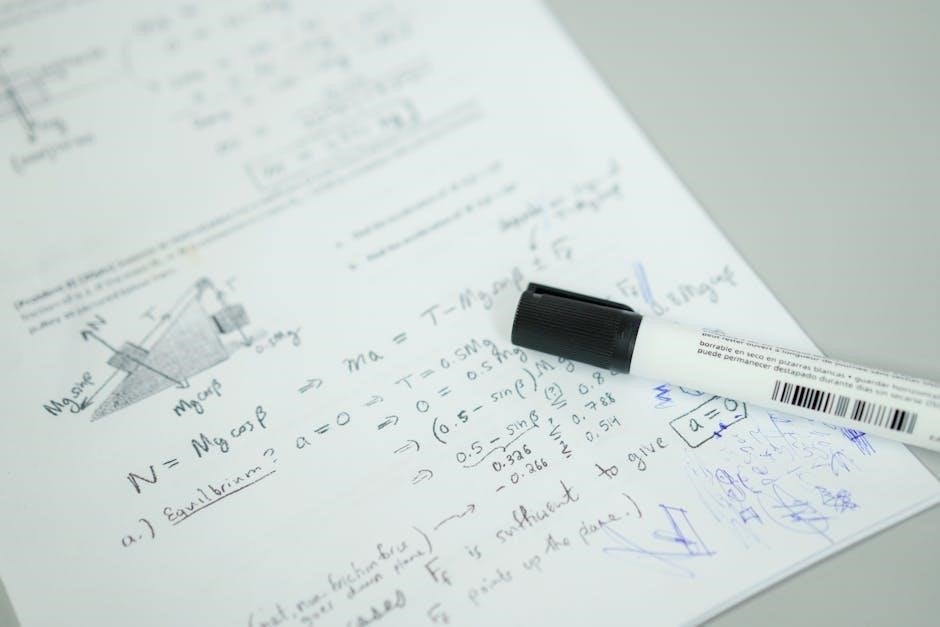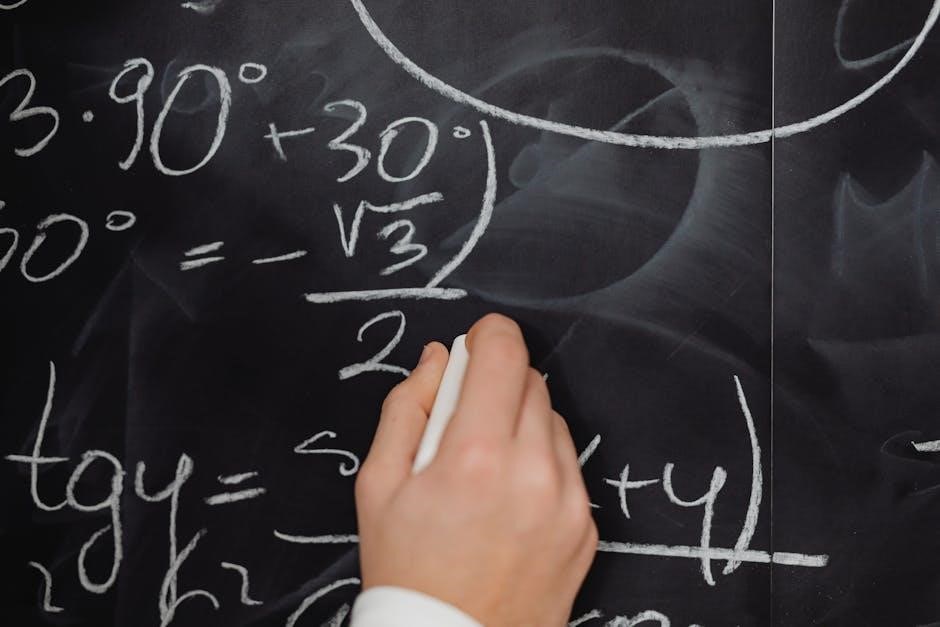Definition and Explanation
A partial differential equation is an equation that involves the derivatives of a multivariable function, which is a function that depends on more than one variable. This type of equation is a natural extension of ordinary differential equations, which involve the derivatives of a single-variable function. Partial differential equations are used to describe a wide range of phenomena in various fields, including physics, engineering, and economics. The definition of a partial differential equation can be given as an equation of the form F(x, u, Du, D2u, …, Dmu) = 0, where u is the unknown function, x is the independent variable, and Du, D2u, …, Dmu are the partial derivatives of u with respect to x. The explanation of partial differential equations involves understanding the properties and behavior of these equations, including their solutions, which can be used to model and analyze real-world problems.
The study of partial differential equations is an important area of mathematics, with many applications in science and engineering. The definition and explanation of partial differential equations provide a foundation for understanding and working with these equations, which is essential for making progress in many fields.
Importance of Partial Differential Equations
The importance of partial differential equations lies in their ability to model and describe a wide range of phenomena in various fields, including physics, engineering, and economics. These equations are used to study the behavior of complex systems, such as fluid dynamics, heat transfer, and wave propagation. The solutions to partial differential equations can provide valuable insights into the underlying mechanisms of these systems, allowing for predictions and optimizations to be made. Furthermore, partial differential equations have numerous applications in real-world problems, such as weather forecasting, image processing, and medical imaging. The study of partial differential equations is essential for making progress in many fields, as it provides a powerful tool for modeling and analyzing complex systems. By understanding the importance of partial differential equations, researchers and scientists can develop new methods and techniques for solving these equations, leading to breakthroughs in various fields and improving our understanding of the world around us.

Types of Partial Differential Equations
Partial differential equations are classified into different types, including linear and nonlinear equations, with various orders and degrees of complexity, used to model various physical phenomena and systems effectively online always.
First Order Partial Differential Equations
First order partial differential equations are a type of equation that involves a function of multiple variables and its first order partial derivatives. These equations are used to model various physical phenomena, such as the flow of fluids and the diffusion of heat. They are also used in other fields, such as economics and biology, to model complex systems and make predictions about future behavior. The solution of first order partial differential equations typically involves the use of techniques such as separation of variables and integrating factors. These techniques allow us to find the general solution of the equation, which can then be used to solve specific problems. In addition, first order partial differential equations can be solved using numerical methods, such as finite difference methods and finite element methods. These methods are useful for solving equations that cannot be solved analytically, and are widely used in many fields. Overall, first order partial differential equations are an important tool for modeling and analyzing complex systems. They have many applications and are used to solve a wide range of problems.
Second Order Partial Differential Equations
Second order partial differential equations are a type of equation that involves a function of multiple variables and its second order partial derivatives. These equations are used to model various physical phenomena, such as wave propagation and vibration. They are classified into different types, including elliptic, parabolic, and hyperbolic equations, each with its own unique characteristics and methods of solution. The classification of second order partial differential equations is important, as it determines the type of solution that can be expected and the methods that can be used to solve the equation; In general, second order partial differential equations are more difficult to solve than first order equations, and require more advanced techniques, such as the use of Fourier analysis and eigenfunction expansions. The study of second order partial differential equations is an active area of research, with many applications in fields such as physics, engineering, and computer science. These equations are used to model complex systems and make predictions about future behavior.

Methods of Solving Partial Differential Equations
Various methods are used to solve partial differential equations, including separation of variables and adjoint operators, to find solutions and analyze problems effectively online always.
Separation of Variables
The method of separation of variables is a technique used to solve partial differential equations, it involves expressing the solution as a product of functions, each depending on a single variable, this allows the equation to be broken down into simpler ordinary differential equations.
The separation of variables method is commonly used to solve problems involving heat transfer, wave propagation, and other physical phenomena, it is a powerful tool for solving partial differential equations.
This method is based on the idea of separating the variables, and then solving the resulting ordinary differential equations, the solution is then constructed by multiplying the solutions of the individual ordinary differential equations.
The separation of variables method is a fundamental technique in the solution of partial differential equations, and is widely used in many fields, including physics, engineering, and mathematics.
It is an important tool for solving problems that involve partial differential equations, and is often used in conjunction with other methods, such as the method of undetermined coefficients.
The separation of variables method is a valuable technique for solving partial differential equations, and is an important part of the toolkit of any mathematician or physicist.
Adjoint Operators and Riemann’s Method
Adjoint operators play a crucial role in the solution of partial differential equations, they are used to define the adjoint equation, which is a useful tool for solving problems involving partial differential equations.
Riemann’s method is a technique used to solve partial differential equations, it involves using the adjoint operator to define a new equation, which is then solved using standard methods.
The adjoint operator is used to define the adjoint equation, which is a partial differential equation that is related to the original equation, the solution of the adjoint equation is then used to construct the solution of the original equation.
This method is commonly used to solve problems involving partial differential equations, it is a powerful tool for solving equations of this type.
The use of adjoint operators and Riemann’s method provides a useful technique for solving partial differential equations, it is an important part of the toolkit of any mathematician or physicist.
The adjoint operator and Riemann’s method are used to solve a wide range of problems involving partial differential equations, they are a valuable tool for solving equations of this type.

Applications of Partial Differential Equations
Partial differential equations have numerous applications in physics, engineering, and finance, modeling real-world phenomena and solving complex problems effectively using various methods and techniques online always.
Nonlinear Partial Differential Equations
Nonlinear partial differential equations are utilized in various fields to model complex phenomena, such as fluid dynamics, quantum mechanics, and relativity. These equations involve nonlinear terms, which make them challenging to solve. Researchers have developed various methods to solve nonlinear partial differential equations, including numerical methods and approximation techniques. The study of nonlinear partial differential equations has led to significant advances in our understanding of complex systems and phenomena. Furthermore, nonlinear partial differential equations have applications in fields such as engineering, physics, and biology. The solution of these equations can provide valuable insights into the behavior of complex systems, allowing for more accurate predictions and simulations. Additionally, the development of new methods and techniques for solving nonlinear partial differential equations continues to be an active area of research, with potential applications in a wide range of fields. Overall, nonlinear partial differential equations play a crucial role in modeling and understanding complex phenomena.
Partial Differential Equations in Deep Learning
Partial differential equations have been increasingly used in deep learning to model complex systems and phenomena. Researchers have developed methods to solve partial differential equations using deep neural networks, which can learn to approximate the solutions to these equations. This approach has been applied to various fields, including physics, engineering, and computer science. The use of partial differential equations in deep learning has led to significant advances in areas such as image and signal processing, and has the potential to revolutionize the field of artificial intelligence. By combining the power of deep learning with the mathematical rigor of partial differential equations, researchers can develop more accurate and efficient models for complex systems. This intersection of partial differential equations and deep learning is a rapidly evolving field, with new applications and techniques being developed continuously. The potential of this approach is vast, and it is likely to have a significant impact on a wide range of fields in the coming years.

and Future Directions
The study of partial differential equations has led to significant advances in various fields, and their importance is expected to continue growing. Researchers are exploring new methods and techniques to solve and analyze partial differential equations, including the use of deep learning and other computational approaches. The development of new numerical methods and algorithms is also an active area of research, with the goal of improving the accuracy and efficiency of solutions. Additionally, the application of partial differential equations to real-world problems, such as those in physics, engineering, and biology, is a key area of focus. As computational power and mathematical techniques continue to evolve, it is likely that partial differential equations will play an increasingly important role in shaping our understanding of complex systems and phenomena. Further research is needed to fully realize the potential of partial differential equations, and to explore new areas of application and development, leading to new discoveries and innovations in the field.

Leave a Reply
You must be logged in to post a comment.